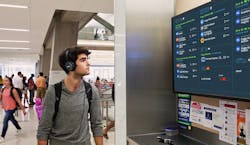The United Nations anticipates that the global urban population will increase by 2.5 billion people by 2050. As the population continues to grow at a rapid rate, approaching an inevitable tipping point in cities around the world, sustainable challenges will arise for transportation systems.
While technology’s play in transportation has resulted in significant strides that have transformed the industry, there is still a long road ahead to solve mobility challenges in some of the most heavily populated cities across the U.S. and on a global scale. How do commuters, residents and visitors alike get from point A to point B in the most convenient, consistent, safe and environmentally sound way? The answer is, with the appropriate combination of technology, innovation, collaboration, investment and adoption.
Technology to Transform Transportation
We’ve experienced the positive impacts of implementing suitable technologies to aid commuters and travelers. From ride-sharing apps, digital travel booking platforms and connected cars, we have improved the way we move from street to street, to different states, and across the globe.
By leveraging connectivity and big data and analytics, cities are pushing the boundaries of smart mobility to reduce congestion and travel time, lower transportation-related emissions and promote walkability technology. Transit hub commuters, students on campuses and visitors exploring a new city can now access up-to-the-minute information and directions through high-density Wi-Fi systems and real-time data and analytics — intelligent technologies are delivering information and services to people on the go at precisely the right moment.
The Internet of Things and Big Data
The Internet of things (IoT) and big data have helped to reinvent operations taking place between users and organizations’ backend business applications or databases, improving operational systems and the customer experience across industries. From retail and healthcare to energy and manufacturing, IoT and big data applications are at work across sectors that impact everyday life and have truly changed the way in which we visualize, develop, connect and consume. When implemented effectively, these technologies can enhance transit-oriented innovation, resolving pain points like train delays, traffic jams and parking restrictions that slow down daily travel in major urban areas across the U.S.
Connectivity
Connected transportation programs with capabilities to meet today’s ever-changing information and data deluge provide real-time data and updates to people, infrastructure and vehicles. These timely updates are laying the groundwork for a system to improve mobility and enable more informed commuting and travel decisions.
On the Road to Smart Mobility
Unlocking transformational results requires out-of-the-box thinking. Smart cities cannot implement smart mobility solutions themselves, it takes support and collaboration between researchers, corporate executives, technology providers and government leaders to transform the commuter and travel experience in some of the most highly populated areas across the country.
Programs like The Department of Transportation's (DOT) Smart Cities Challenge serve as catalysts for innovative thinking. The program, which launched in December 2015, put out the call-to-action for mid-sized cities across the country to develop integrated, first-of-their-kind smart transportation systems. DOT received applications from 78 cities hoping to enhance their mobility solutions, and seven finalists worked with DOT to further develop their ideas
Cities across the U.S., including Denver, are working to reimagine the systems tasked with powering their communities by installing technology to gather useful data that ultimately saves money, reduces traffic, increases safety and improves urban life. Denver is among those at the forefront of smart mobility. The city has maximized efforts by implementing a robust IoT platform that supports a variety of Smart City projects, collecting and integrating transportation, environmental health, weather and freight data. By leveraging smart and sustainable technology, the Mile High City is pioneering a truly connected infrastructure of technology that’s affordable and environmentally sustainable for residents and visitors alike.
In addition to Denver’s notable smart mobility progress there’s also Colorado’s autonomous driving and vehicles push. Connected vehicles are upon us, from vehicle to vehicle (V2V) technologies to vehicle to infrastructure (V2X), we are unlocking the most robust mobility data experienced in human history and ultimately transforming the way we travel. The potential to make lives easier and increase safety positions connected vehicles among some of the most impactful technologies in the past half century. Colorado Department of Transportation (CDOT), the city of Denver and the state of Colorado are leading the way, ultimately speeding up the acceptance curve for V2X and additional autonomous solutions capable of changing the way in which we travel.
While no one single solution can solve mobility challenges, a more connected mobility experience that enables on-demand rides, ubiquitous payment platforms across all mobility options, safer roadways, and smarter, connected vehicles will absolutely pave the way for more functional deployments of autonomous technology. Technology providers like Panasonic are addressing and alleviating many mobility choke-points through IoT connected solutions that span mobility, streetscapes, building living, energy and digital engagement. Panasonic is continuing to develop forward-thinking, user-centric solutions that connect people, towns, road and air transport to enhance that quality of life for both citizens and municipalities.
Jarrett Wendt is the executive vice president of Panasonic Enterprise Solutions Company.
